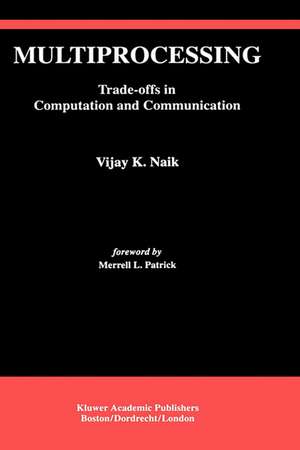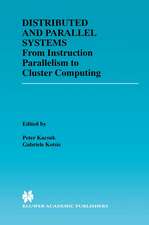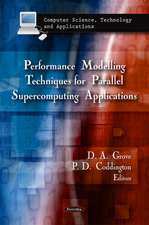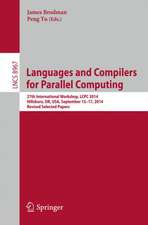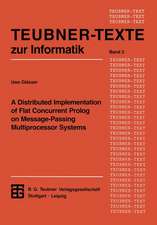Multiprocessing: Trade-Offs in Computation and Communication: The Springer International Series in Engineering and Computer Science, cartea 236
Autor Vijay K. Naiken Limba Engleză Hardback – 31 iul 1993
Starting with simple, two-dimensional, diamond-shaped directed acyclic graphs, the analysis is extended to more complex and higher dimensional directed acyclic graphs. The analysis allows for the quantification of the computation and communication costs and their interdependencies. The practical significance of these results on the performance of various data distribution schemes is clearly explained. Using these results, the performance of the parallel computations are formulated in an architecture independent fashion. These formulations allow for the parameterization of the architecture specitific entities such as the computation and communication rates. This type of parameterized performance analysis can be used at compile time or at run-time so as to achieve the most optimal distribution of the computations.
The material in Multiprocessing: Trade-Offs in Computation and Communication connects theory with practice, so that the inherent performance limitations in many computations can be understood, and practical methods can be devised that would assist in the development of software for scalable high performance systems.
| Toate formatele și edițiile | Preț | Express |
|---|---|---|
| Paperback (1) | 641.87 lei 6-8 săpt. | |
| Springer Us – 27 sep 2012 | 641.87 lei 6-8 săpt. | |
| Hardback (1) | 648.44 lei 6-8 săpt. | |
| Springer Us – 31 iul 1993 | 648.44 lei 6-8 săpt. |
Din seria The Springer International Series in Engineering and Computer Science
- 24%
 Preț: 1041.98 lei
Preț: 1041.98 lei - 20%
 Preț: 643.50 lei
Preț: 643.50 lei - 18%
 Preț: 1225.62 lei
Preț: 1225.62 lei - 18%
 Preț: 965.02 lei
Preț: 965.02 lei - 20%
 Preț: 646.12 lei
Preț: 646.12 lei - 18%
 Preț: 948.79 lei
Preț: 948.79 lei - 20%
 Preț: 646.62 lei
Preț: 646.62 lei - 15%
 Preț: 637.46 lei
Preț: 637.46 lei - 20%
 Preț: 643.83 lei
Preț: 643.83 lei - 18%
 Preț: 949.23 lei
Preț: 949.23 lei - 20%
 Preț: 644.48 lei
Preț: 644.48 lei - 20%
 Preț: 994.92 lei
Preț: 994.92 lei - 20%
 Preț: 645.97 lei
Preț: 645.97 lei - 18%
 Preț: 946.87 lei
Preț: 946.87 lei - 20%
 Preț: 995.57 lei
Preț: 995.57 lei - 18%
 Preț: 956.99 lei
Preț: 956.99 lei - 20%
 Preț: 644.98 lei
Preț: 644.98 lei - 15%
 Preț: 649.54 lei
Preț: 649.54 lei - 18%
 Preț: 950.21 lei
Preț: 950.21 lei - 18%
 Preț: 1221.38 lei
Preț: 1221.38 lei - 18%
 Preț: 957.62 lei
Preț: 957.62 lei - 15%
 Preț: 643.99 lei
Preț: 643.99 lei - 18%
 Preț: 948.47 lei
Preț: 948.47 lei - 18%
 Preț: 947.35 lei
Preț: 947.35 lei - 20%
 Preț: 1284.65 lei
Preț: 1284.65 lei - 20%
 Preț: 1628.31 lei
Preț: 1628.31 lei - 20%
 Preț: 1285.78 lei
Preț: 1285.78 lei
Preț: 648.44 lei
Preț vechi: 810.55 lei
-20% Nou
Puncte Express: 973
Preț estimativ în valută:
124.12€ • 134.87$ • 104.33£
124.12€ • 134.87$ • 104.33£
Carte tipărită la comandă
Livrare economică 21 aprilie-05 mai
Preluare comenzi: 021 569.72.76
Specificații
ISBN-13: 9780792393702
ISBN-10: 0792393708
Pagini: 198
Ilustrații: XXI, 198 p.
Dimensiuni: 155 x 235 x 14 mm
Greutate: 0.5 kg
Ediția:1993
Editura: Springer Us
Colecția Springer
Seria The Springer International Series in Engineering and Computer Science
Locul publicării:New York, NY, United States
ISBN-10: 0792393708
Pagini: 198
Ilustrații: XXI, 198 p.
Dimensiuni: 155 x 235 x 14 mm
Greutate: 0.5 kg
Ediția:1993
Editura: Springer Us
Colecția Springer
Seria The Springer International Series in Engineering and Computer Science
Locul publicării:New York, NY, United States
Public țintă
ResearchCuprins
1 Introduction.- 1.1 Parallel computing and communication.- 1.2 Scope of this work.- 1.3 Organization.- 1.4 Model of computation.- 1.5 Graph-theoretic definitions.- 1.6 Basic terminology.- 2 Diamond Dags.- 2.1 Communication requirements of a DAG.- 2.2 The diamond dag.- 2.3 Diamond dags with higher degree vertices.- 2.4 Effects of the tradeoff on performance.- 2.5 Concluding remarks.- 3 Rectangular Dags.- 3.1 The rectangular dag.- 3.2 Lower bound on computation time.- 3.3 Lower bound on data traffic.- 3.4 Lower bound on t • ?.- 3.5 The tradeoff factor for the rectangular dag.- 3.6 Performance considerations.- 3.7 Concluding remarks.- 4 Three and Higher Dimensional Dags.- 4.1 An n X n X n dag.- 4.2 A d–dimensional dag.- 4.3 The effects of tradeoff on performance.- 4.4 Concluding remarks.- 5 Factoring Dense and Sparse Matrices.- 5.1 Dense symmetric positive definite systems.- 5.2 Sparse, symmetric positive definite systems.- 5.3 Concluding remarks.- 6 Conclusions and Some Open Issues.- 6.1 Summary of principal results.- 6.2 Suggestions for further research.
